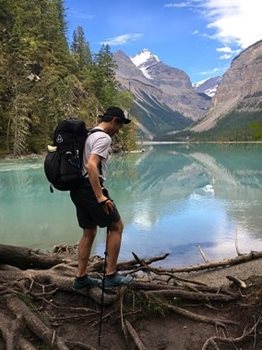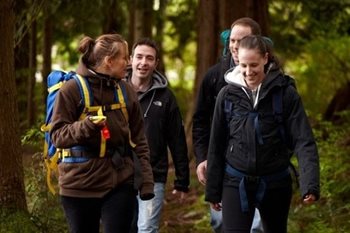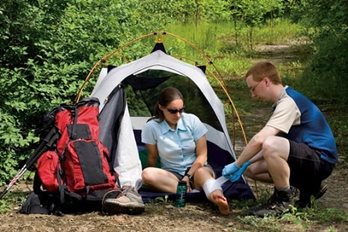 Canada is well known for its stunning and vast wilderness – and the adventurous people who explore it. There’s a certain sense of challenge and satisfaction that comes with backcountry expeditions – relying on yourself and your survival skills while immersed in nature.
Canada is well known for its stunning and vast wilderness – and the adventurous people who explore it. There’s a certain sense of challenge and satisfaction that comes with backcountry expeditions – relying on yourself and your survival skills while immersed in nature.At the same time, adventuring in the wilderness comes with undeniable risks. Each year, the media reports tragic tales of ill-fated trips to remote areas.
Backcountry first aid emergencies can include exposure to poisonous plants or animals, and injuries from falling while hiking or climbing.
In tough terrain, or sudden extreme weather, you might lose your bearings – and the trail. Your canoe or kayak could overturn in cold, unknown waters. Someone in your group may experience a heart attack or other medical emergency. Navigation and communication devices may fail or break.
How confident would you be to handle any of these scenarios while far from help? Could you respond and recover if the unexpected happens? In this blog, we’ll share practical safety and prevention tips, common emergencies and a checklist of backpack essentials to help you prepare for your next backcountry excursion.
Planning and training key to safe wilderness adventures
Wilderness and remote environments require specialized skills, equipment and training. At the Canadian Red Cross, we strongly advise adventurers heading off the beaten path to develop the necessary first aid, planning and prevention skills in case of remote emergencies. First aid scenarios that wouldn’t typically be of concern in urban areas can quickly become serious emergencies in remote settings.
 Take the time to research and learn about the wildlife and climate in the area you’ll be exploring, as well as the kind of activity to expect at that time of year. It may be flood season, mating season, hunting season, or the end of hibernation season, for example. While in and around parks and trails, pay attention to all posted signs with warnings about unsafe weather or terrain conditions, as well as wildlife activity to watch for.
Take the time to research and learn about the wildlife and climate in the area you’ll be exploring, as well as the kind of activity to expect at that time of year. It may be flood season, mating season, hunting season, or the end of hibernation season, for example. While in and around parks and trails, pay attention to all posted signs with warnings about unsafe weather or terrain conditions, as well as wildlife activity to watch for.Common wilderness ailments include blisters, heat exhaustion, hypothermia, and cuts, scrapes and breaks. What may seem like a minor wound could become a life-threatening infection if not cleaned and treated properly.
Prevent stings and bites as much as possible by staying away from tall grass and underbrush, wearing light, loose-fitting clothing and using insect repellant. If you do get bitten or stung, follow these first aid steps.
Inexperienced foragers and explorers may touch or ingest berries, mushrooms and other plants that are toxic, and sometimes lethal. Even touching certain types of trees, leaves and bushes can transfer poison through our skin and into our bodies. Do your homework before leaving home so that you’ll be able to recognize which plants are safe and which are to be avoided.
 At any point on your journey, an unexpected encounter with wildlife can result in a serious first aid emergency, far from the help of medics and hospitals. Snakes, bears, and even moose can pose a threat.
At any point on your journey, an unexpected encounter with wildlife can result in a serious first aid emergency, far from the help of medics and hospitals. Snakes, bears, and even moose can pose a threat.Learn about the animals, reptiles and insects that you could find along your path, or in their natural habitat, and how to avoid them.
Remember, you’re in their territory. Operate with safety and respect.
No such thing as “too prepared”
Inexperienced outdoor enthusiasts, including tourists and newcomers, may be less familiar with the Canadian climate and wilderness.Before starting out on an adventure, make an honest assessment of your abilities and preparedness.
Even experienced wilderness folk can find themselves in a dangerous situation, so frequently reviewing best practices and refreshing first aid skills are key to a safe, successful backcountry expedition.
12 wilderness first aid and safety essentials to pack
In the Canadian wilderness, you’ll need specific equipment to be better prepared in an emergency. This checklist will help you pack some key essentials:
1. Knife – including a locking blade, corkscrew, saw, screwdriver, and tweezers
2. Fire-making supplies – a lighter or matches, pieces of wood and paper kindling
3. Whistle – one that is shrill, works in cold and wet conditions, with sound that carries through a storm or wind
4. Navigation aids – a quality compass and area map
5. Sun protection – sunscreen, lip balm, sunglasses, hat
6. Insect protection – insect repellent spray, tick removal kit, loose clothing with long sleeves and legs, fly net
7. First aid kit – check what to include here, including medication
8. Emergency food and water – energy bars, dried fruit, nuts, filtered water
9. Emergency clothing – extra layers of synthetic fabrics or wool, a warm hat
10. Light – a headlamp or flashlight with extra batteries
11. Shelter – a Mylar blanket with a rope attached to each corner
12. Mobile Phone – make sure it’s fully charged and bring a back-up power source to recharge
Of course, you’ll also personalize your packing list to contain the supplies and equipment you’ll rely on when far from home. Your gear packing will also depend on the environment, weather, and activities you’re planning, like hiking, camping or boating.
Learn wilderness first aid skills with the Red Cross this summer
 In the wilderness or remote areas, any first aid emergency becomes much more urgent. With some planning and preparedness, and adequate training, you can be ready to respond no matter how far from home you are.
In the wilderness or remote areas, any first aid emergency becomes much more urgent. With some planning and preparedness, and adequate training, you can be ready to respond no matter how far from home you are.The Red Cross Wilderness & Remote First Aid Program is one of the leading programs of its kind in Canada – and a great place to start! Whether you’re an outdoor recreation enthusiast, live or work in a remote setting, or work as a professional rescuer, the Red Cross offers specialized training for wilderness environments, including:
Remote First Aid - for people who live or work in non-urban, remote or wilderness workplaces or communities.
Wilderness First Aid - for people who wish to become professional guides, parks officials and/or work in fields like recreation and ecotourism.
Wilderness First Responder - for professional rescuers who work in remote settings in advanced first aid and CPR, leadership and rescue decision-making
Adventure calls – it’s time to explore nature while make new memories, safely!
Interested in taking Wilderness and Remote First Aid training? Find a course in your community or online. We also offer practical first aid resources to help you be better prepared for your next backcountry adventure. Share this story with the adventurous explorers in your life!
Related stories:

